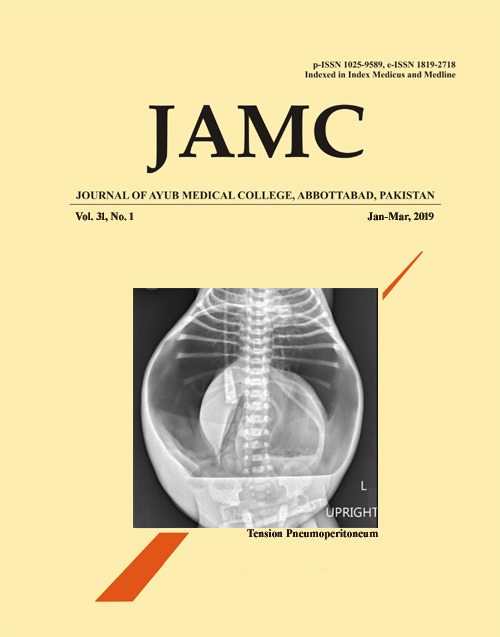MUTATIONAL ANALYSIS OF BETA THALASSAEMIA BY MULTIPLEX ARMS-PCR IN KHYBER PAKHTUNKHWA, PAKISTAN
Abstract
Background: Beta thalassaemia is one of the commonest genetic condition in the world. More than 200 different mutations have been reported in the beta globin chain genes. Notably, regional and ethnic variations in most common mutations in beta-thalassaemia have been identified. It is therefore imperative that region- and ethnicity- specific commonest mutations be identified for cost-effective molecular diagnosis of β-thalassaemia mutations. The objective of this study was to determine the molecular mutations in β-globin chain gene in patients with thalassemia in Khyber Pakhtunkhwa (KP) using multiplex- Amplification Refractory Mutation System (ARMS) PCR. Methods: It was a cross sectional descriptive study. Blood samples from newly diagnosed β thalassemia patients was collected and used as source for DNA isolation. ARMS PCR was performed for detection of mutations in β-globin gene. SDS-PAGE was conducted for visualization of the amplicon. Results: Prominent mutations were Fr 8-9 (+G), CD 5 (-CT) and Fr 41-42 (-TTCT). Congenital marriages and lack of awareness are largest contributing factor for increasing the disease burden. Organomegaly being a serious clinical complication which contributes to morbidity was proportional to age and disease progression. Fr 8-9 (+G) & CD 5 (-CT) were the most frequent mutation prevalent among different ethnic groups residing in KP. Conclusions: Multiplex-ARMS PCR is capable of assessing for multiple mutations in a single tube. Regional- and ethnic- variations in the commonest mutations in KP are noted. Any mutational diagnostic strategy should consider costs and genetic variations in a particular setting. Keywords: Beta Thalassemia; β-Thalassaemia; mutation frequency; allele distributionReferences
Aksoy M. Thalassaemia intermedia: a genetic study in 11 patients. J Med Genet 1970;7(1):47–51.
Weatherall D. Molecular biology at the bedside. Br Med J (Clin Res Ed) 1986;292(6534):1505–8.
Galanello R, Origa R. Beta-thalassemia. Orphanet J Rare Dis 2010;5:11.
Cousens NE, Gaff CL, Metcalfe SA, Delatycki MB. Carrier screening for Beta-thalassaemia: a review of international practice. Eur J Hum Genet 2010;18(10):1077–83.
Mishra KK, Patel P, Bhukhanvala DS, Shah A, Ghosh K. A multiplex ARMS PCR approach to detection of common β-globin gene mutations. Anal Biochem 2017;537:93–8.
Ahmed S, Petrou M, Saleem M. Molecular genetics of beta-thalassaemia in Pakistan: a basis for prenatal diagnosis. Br J Haematol 1996;94(3):476–82.
Baig SM, Azhar A, Hassan H, Baig JM, Aslam M, Din U, et al. Prenatal diagnosis of β‐thalassemia in Southern Punjab, Pakistan. Prenat Diagn 2006;26(10):903–5.
Ahmed S, Saleem M, Sultana N, Raashid Y, Waqar A, Anwar M, et al. Prenatal diagnosis of beta‐thalassaemia in Pakistan: experience in a Muslim country. Prenat Diagn 2000;20(5):378–83.
Hafeez M, Aslam M, Ali A, Rashid Y, Jafri H. Regional and ethnic distribution of beta thalassemia mutations and effect of consanguinity in patients referred for prenatal diagnosis. J Coll Physicians Surg Pak 2007;17(3):144–7.
Baig S, Azhar A, Hassan H, Baig J, Kiyani A, Hameed U, et al. Spectrum of beta-thalassemia mutations in various regions of Punjab and Islamabad, Pakistan: establishment of prenatal diagnosis. Haematologica 2006;91(3):ELT02.
Ansari SH, Shamsi TS, Ashraf M, Farzana T, Bohray M, Perveen K, et al. Molecular epidemiology of β-thalassemia in Pakistan: Far reaching implications. Indian J Hum Genet 2012;18(2):193–7.
Khattak SAK, Ahmed S, Anwar J, Ali N, Shaikh KH. Prevalence of various mutations in beta thalassaemia and its association with haematological parameters. J Pak Med Assoc 2012;62(1):40–3.
Shakeel M, Arif M, Rehman SU, Yaseen T. Investigation of molecular heterogeneity of β-thalassemia disorder in District Charsadda of Pakistan. Pak J Med Sci 2016;32(2):491–4.
Black M, Sinha S, Agarwal S, Colah R, Das R, Bellgard M, et al. A descriptive profile of β-thalassaemia mutations in India, Pakistan and Sri Lanka. J Community Genet 2010;1(3):149–57.
Rahim F, Abromand M. Spectrum of ß-Thalassemia mutations in various Ethnic Regions of Iran. Pak J Med Sci 2008;24(3):410–5.
Ibn Ayub M, Moosa MM, Sarwardi G, Khan W, Khan H, Yeasmin S. Mutation Analysis of the HBB Gene in Selected Bangladeshi β-Thalassemic Individuals: Presence of Rare Mutations. Genet Test Mol Biomarkers 2010;14(3):299–302.
Published
Issue
Section
License
Journal of Ayub Medical College, Abbottabad is an OPEN ACCESS JOURNAL which means that all content is FREELY available without charge to all users whether registered with the journal or not. The work published by J Ayub Med Coll Abbottabad is licensed and distributed under the creative commons License CC BY ND Attribution-NoDerivs. Material printed in this journal is OPEN to access, and are FREE for use in academic and research work with proper citation. J Ayub Med Coll Abbottabad accepts only original material for publication with the understanding that except for abstracts, no part of the data has been published or will be submitted for publication elsewhere before appearing in J Ayub Med Coll Abbottabad. The Editorial Board of J Ayub Med Coll Abbottabad makes every effort to ensure the accuracy and authenticity of material printed in J Ayub Med Coll Abbottabad. However, conclusions and statements expressed are views of the authors and do not reflect the opinion/policy of J Ayub Med Coll Abbottabad or the Editorial Board.
USERS are allowed to read, download, copy, distribute, print, search, or link to the full texts of the articles, or use them for any other lawful purpose, without asking prior permission from the publisher or the author. This is in accordance with the BOAI definition of open access.
AUTHORS retain the rights of free downloading/unlimited e-print of full text and sharing/disseminating the article without any restriction, by any means including twitter, scholarly collaboration networks such as ResearchGate, Academia.eu, and social media sites such as Twitter, LinkedIn, Google Scholar and any other professional or academic networking site.









